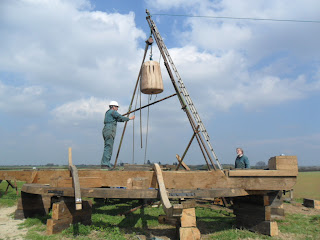Here is the whip with the sail bars fitted.
After this, the lead boards (visible on the right hand side) were fitted. These smooth the airflow onto the canvas (when it's fitted).
Next job will be the long members which run at ninety degrees to the sail bars (uplong and hemlath). Unlike the whip, these will be made of several lengths spliced together (one piece is visible lying on top of the sail, on the left side).
Meanwhile, we have made some minor modifications to the outside of the mill itself. We have noticed that, in driving rain, some water has been getting in just above the lintels, mainly at the upper windows. It is a weakness with timber lintels against stonework; as the timber dries and moves, a slight gap inevitably forms. There was no evidence of any hoods having been fitted to these windows originally, but we have decided to fit small strips, with lead flashing, to help prevent this water ingress. It changes the aesthetics of the tower only slightly and, more importantly, it should help prolong the life of the mill. Any water entering here could affect the new spliced beam ends which were fitted at the start of the project (perhaps the originals were so rotten, at least in part, due to a lack of protection over the lintels). The usual problem; where do you restore faithfully, where do you improve, where do you renew. It isn't easy, but we try our best......



































